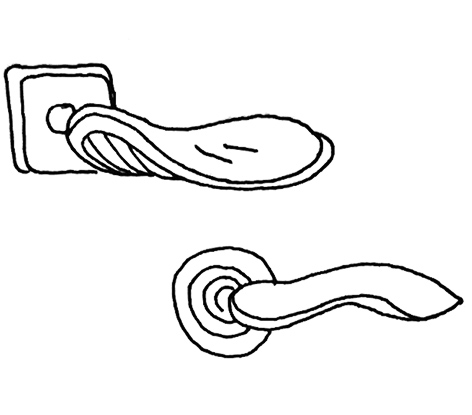12.1. Handles
Aus Pattern Language Wiki
Intimately related to the Place Network and its function is the perception and physical ability to grasp our surroundings. Provide functional but also ergonomic handles on an entrance and within a room.
Problem-statement: People need to experience human-scaled handles in their surroundings, which include functional handles on doors and windows, and also frames, ledges, and trim having a ‘graspable’ dimension.
Discussion: We are continuously judging whether our immediate environment provides ‘affordance’, which is the ability to accommodate our body and especially our hands. This notion is essential in using tools and utensils, but we point out that it is also crucial in ‘fitting-into’ the built environment.
We feel comfortable in a room if we sense its range of human dimensions. There is no better way to do this than by having obvious structures of a ‘graspable’ dimension. Built features such as moldings, trim, etc. are usually associated with ornamentation, but are in reality quite distinct and equally necessary for psychological wellbeing. Psychologist James J. Gibson used the notion of affordance1 to explain how we fit (or not) into our immediate environment, which was developed further by Donald Norman.² This idea goes far deeper into both physics and the world’s religions, in a philosophy of connecting the Cosmos to small details that humans experience in everyday life. The German physicist Ernst Mach stated the principle that “local physical laws are determined by the large-scale structure of the universe”. This idea was instrumental to Albert Einstein in developing the General Theory of Relativity. At the same time, in many traditional religions, especially Eastern ones, it is accepted that what we experience here locally is connected to the large-scale structure of the Cosmos. The idea of small/large connectivity is backed by millennia of human thought about how human beings fit into the Universe. Therefore, design cannot arbitrarily choose to ignore such powerful precedents.
The quality of handles may ultimately provide the quickest test of whether a new building is good or not. If the designer has truly thought about accommodating the human hand and psyche in designing comfortable door handles and other features on a ‘graspable’ scale, then they have probably paid the same attention to guarantee the affordance of other elements such as room shape, ceiling height, indoor lighting, circulation realms, etc. The opposite is also valid: an uncomfortable door handle probably indicates that the entire building in all its details is non-accommodating.
Therefore:
Pay special attention to include structural features that are shaped to be easily ‘graspable’ by the hand, which fit comfortably, even if we never need to physically grasp them. Actual handles should revert to older ergonomic design and abandon the ubiquitous uncomfortable shapes due to abstract ‘design’.
On doors and windows use well-known psychological design techniques to indicate whether one needs to push or pull, rather than a minimalistic design aesthetic that confuses the user…
¹ See Gibson, J.J. (1979). “The Theory of Affordances.” In The Ecological Approach to Visual Perception. Boston, MA, US: Houghton, Mifflin and Company.
² Norman, D. A. (1999). Affordance, Conventions, and Design. Interactions, 6(3), 38-43.
Mehaffy, M. et al. (2020). HANDLES (pattern). In A New Pattern Language for Growing Regions. The Dalles: Sustasis Press. Available at https://pattern-language.wiki/.../Handles
SECTION I:
PATTERNS OF SCALE
1. REGIONAL PATTERNS
Define the large-scale spatial organization…
1.4. 400M THROUGH STREET NETWORK
2. URBAN PATTERNS
Establish essential urban characteristics…
3. STREET PATTERNS
Identify and allocate street types…
4. NEIGHBORHOOD PATTERNS
Define neighborhood-scale elements…
5. SPECIAL USE PATTERNS
Integrate unique urban elements with care…
6. PUBLIC SPACE PATTERNS
Establish the character of the crucial public realm…
7. BLOCK AND PLOT PATTERNS
Lay out the detailed structure of property lines…
8. STREETSCAPE PATTERNS
Configure the street as a welcoming place…
9. BUILDING PATTERNS
Lay out appropriate urban buildings…
10. BUILDING EDGE PATTERNS
Create interior and exterior connectivity…
10.1. INDOOR-OUTDOOR AMBIGUITY
SECTION II:
PATTERNS OF MULTIPLE SCALE
11. GEOMETRIC PATTERNS
Build in coherent geometries at all scales…
11.2. SMALL GROUPS OF ELEMENTS
12. AFFORDANCE PATTERNS
Build in user capacity to shape the environment…
13. RETROFIT PATTERNS
Revitalize and improve existing urban assets …
14. INFORMAL GROWTH PATTERNS
Accommodate “bottom-up” urban growth…
15. CONSTRUCTION PATTERNS
Use the building process to enrich the result…
SECTION III:
PATTERNS OF PROCESS
16. IMPLEMENTATION TOOL PATTERNS
Use tools to achieve successful results…
16.2. ENTITLEMENT STREAMLINING
16.3. NEIGHBORHOOD PLANNING CENTER
17. PROJECT ECONOMICS PATTERNS
Create flows of money that support urban quality…
17.4. ECONOMIES OF PLACE AND DIFFERENTIATION
18. PLACE GOVERNANCE PATTERNS
Processes for making and managing places…
18.3. PUBLIC-PRIVATE PLACE MANAGEMENT
19. AFFORDABILITY PATTERNS
Build in affordability for all incomes…
19.1. INTEGRATED AFFORDABILITY
20. NEW TECHNOLOGY PATTERNS
Integrate new systems without damaging old ones…
20.2. RESPONSIVE TRANSPORTATION NETWORK COMPANY

